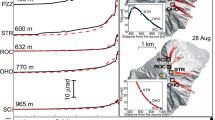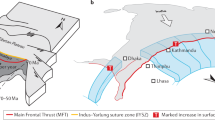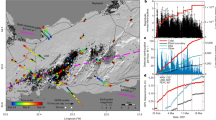Abstract
The largest effusive basaltic eruptions are associated with caldera collapse and are manifest through quasi-periodic ground displacements and moderate-size earthquakes1,2,3, but the mechanism that governs their dynamics remains unclear. Here we provide a physical model that explains these processes, which accounts for both the quasi-periodic stick–slip collapse of the caldera roof and the long-term eruptive behaviour of the volcano. We show that it is the caldera collapse itself that sustains large effusive eruptions, and that triggering caldera collapse requires topography-generated pressures. The model is consistent with data from the 2018 Kīlauea eruption and allows us to estimate the properties of the plumbing system of the volcano. The results reveal that two reservoirs were active during the eruption, and place constraints on their connectivity. According to the model, the Kīlauea eruption stopped after slightly more than 60 per cent of its potential caldera collapse events, possibly owing to the presence of the second reservoir. Finally, we show that this physical framework is generally applicable to the largest instrumented caldera collapse eruptions of the past fifty years.
This is a preview of subscription content, access via your institution
Access options
Access Nature and 54 other Nature Portfolio journals
Get Nature+, our best-value online-access subscription
$29.99 / 30 days
cancel any time
Subscribe to this journal
Receive 51 print issues and online access
$199.00 per year
only $3.90 per issue
Buy this article
- Purchase on Springer Link
- Instant access to full article PDF
Prices may be subject to local taxes which are calculated during checkout




Similar content being viewed by others
Data availability
Tilt data are available in ref. 5 and Sentinel SAR data are available at https://sentinel.esa.int/web/sentinel/sentinel-data-access. Source data are provided with this paper.
Code availability
The codes used in this work are available through Zenodo at https://zenodo.org/record/4500189#.YE_LI7RKiWg.
References
Kumagai, H. et al. Very-long-period seismic signals and caldera formation at Miyake island, Japan. Science 293, 687–690 (2001).
Michon, L., Massin, F., Famin, V., Ferrazzini, V. & Roult, G. Basaltic calderas: collapse dynamics, edifice deformation, and variations of magma withdrawal. J. Geophys. Res. Solid Earth 116, B03209 (2011).
Neal, C. et al. The 2018 rift eruption and summit collapse of Kīlauea volcano. Science 363, 367–374 (2019).
Lipman, P. W. C. Encyclopedia of Volcanoes 643–662 (Academic, 2000).
Johanson, I. & Miklius, A. Tiltmeter data from Kīlauea Volcano, Hawaiʻi, spanning the 2018 eruption and earthquake sequence. US Geological Survey Data Release https://doi.org/10.5066/P9310M9N (US Geological Survey, 2019).
Lundgren, P. R., Bagnardi, M. & Dietterich, H. Topographic changes during the 2018 Kīlauea eruption from single-pass airborne InSAR. Geophys. Res. Lett. 46, 9554–9562 (2019).
Fontaine, F. R., Roult, G., Michon, L., Barruol, G. & Muro, A. D. The 2007 eruptions and caldera collapse of the Piton de la Fournaise volcano (la Réunion island) from tilt analysis at a single very broadband seismic station. Geophys. Res. Lett. 41, 2803–2811 (2014).
Ukawa, M., Fujita, E., Yamamoto, E., Okada, Y. & Kikuchi, M. The 2000 Miyakejima eruption: crustal deformation and earthquakes observed by the NIED Miyakejima observation network. Earth Planets Space 52, xix–xxvi (2000).
Liu, Y.-K., Ruch, J., Vasyura-Bathke, H. & Jonsson, S. Influence of ring faulting in localizing surface deformation at subsiding calderas. Earth Planet. Sci. Lett. 526, 115784 (2019).
Gudmundsson, M. T. et al. Gradual caldera collapse at Bárdarbunga volcano, Iceland, regulated by lateral magma outflow. Science 353, aaf8988 (2016).
Ripepe, M. et al. Volcano seismicity and ground deformation unveil the gravity-driven magma discharge dynamics of a volcanic eruption. Nat. Commun. 6, 6998 (2015).
Fialko, Y. A. & Rubin, A. M. What controls the along-strike slopes of volcanic rift zones? J. Geophys. Res. Solid Earth 104, 20007–20020 (1999).
Pinel, V. & Jaupart, C. Magma storage and horizontal dyke injection beneath a volcanic edifice. Earth Planet. Sci. Lett. 221, 245–262 (2004).
Andronov, A. A., Vitt, A. A. & Khaikin, S. E. Theory of Oscillators: Adiwes International Series in Physics Vol. 4 (Elsevier, 2013).
Anderson, K. R. et al. Magma reservoir failure and the onset of caldera collapse at Kīlauea volcano in 2018. Science 366, eaaz1822 (2019).
Poland, M. P. et al. in Characteristics of Hawaiian Volcanoes Vol. 1801, 179–234 (US Geological Survey, 2014).
Salvatier, J., Wiecki, T. V. & Fonnesbeck, C. Probabilistic programming in Python using PyMC3. PeerJ Comput. Sci. 2, e55 (2016).
Patrick, M. et al. Cyclic lava effusion during the 2018 eruption of Kīlauea volcano. Science 366, eaay9070 (2019).
Wu, S.-M., Lin, F.-C., Farrell, J., Shiro, B., Karlstrom, L., Okubo, P., and Koper, K. Spatiotemporal seismic structure variations associated with the 2018 Kīlauea eruption based on temporary dense geophone arrays. Geophys. Res. Lett. 47, e2019GL086668 2019.
Costa, A., Melnik, O. & Sparks, R. Controls of conduit geometry and wallrock elasticity on lava dome eruptions. Earth Planet. Sci. Lett. 260, 137–151 (2007).
Epp, D., Decker, R. W. & Okamura, A. T. Relation of summit deformation to east rift zone eruptions on Kīlauea Volcano, Hawaiʻi. Geophys. Res. Lett. 10, 493–496 (1983).
Iverson, R. M. et al. Dynamics of seismogenic volcanic extrusion at Mount St Helens in 2004–05. Nature 444, 439–443 (2006).
Roche, O. & Druitt, T. H. Onset of caldera collapse during ignimbrite eruptions. Earth Planet. Sci. Lett. 191, 191–202 (2001).
Chen, C. W. & Zebker, H. A. Network approaches to two-dimensional phase unwrapping: intractability and two new algorithms. J. Opt. Soc. Am. A 17, 401–414 (2000).
Agram, P. et al. New radar interferometric time series analysis toolbox released. Eos 94, 69–70 (2013).
Lohman, R. B. & Simons, M. Some thoughts on the use of InSAR data to constrain models of surface deformation: noise structure and data downsampling. Geochem. Geophys. Geosyst. 6, Q01007 (2005).
Mogi, K. Relations between the eruptions of various volcanoes and the deformations of the ground surfaces around them. Bull. Earthq. Res. Inst. 36, 99–134 (1958).
Baker, S. & Amelung, F. Top-down inflation and deflation at the summit of Kīlauea volcano, Hawai’i observed with InSAR. J. Geophys. Res. Solid Earth 117, B12406 (2012).
Segall, P., Anderson, K. R., Pulvirenti, P., Wang, T. and Johanson I. Caldera collapse geometry revealed by near-field GPS displacements at Kīlauea Volcano in 2018. Geophys. Res. Lett. 47, e2020GL088867 (2020).
Dietterich, H. R. et al. Lava effusion rate evolution and erupted volume during the 2018 Kīlauea lower East Rift Zone eruption. Bull. Volcanol. 83, 25 (2021); https://doi.org/10.1007/s00445-021-01443-6.
Acknowledgements
We acknowledge I. Johanson and the Hawaiian Volcano Observatory for providing tiltmeters and GPS stations data. A.R. acknowledges support from the NASA Postdoctoral Program and the Universities Space Research Association, through a NASA-ASI (Italian Space Agency) agreement. We are grateful to M. Patrick and E. Rivalta for their constructive reviews, which helped to improve the clarity and completeness of the manuscript. Part of this research was carried out at the Jet Propulsion Laboratory, California Institute of Technology, under a contract with the National Aeronautics and Space Administration (grant 281945.02.47.05.24).
Author information
Authors and Affiliations
Contributions
A.R. developed the theory and performed the inversions. P.L. processed InSAR data and provided support with critical discussions of the results. Both authors contributed to the manuscript writing.
Corresponding author
Ethics declarations
Competing interests
The authors declare no competing interests.
Additional information
Peer review information Nature thanks Matthew Patrick and Eleonora Rivalta for their contribution to the peer review of this work. Peer reviewer reports are available.
Publisher’s note Springer Nature remains neutral with regard to jurisdictional claims in published maps and institutional affiliations.
Extended data figures and tables
Extended Data Fig. 1 Time between collapses for Piton de la Fournaise, Miyakejima, Fernandina2 and Kīlauea.
Extended Data Fig. 2 Tilt data.
a, North–south component of tilt recorded at UWD. This average signal was obtained by stacking 24-h periods of 19 collapses between 3 July and the end of the eruption. The shaded area corresponds to 2 s.d. of the stacking. The best fit of the function Aexp(ξ1t) + Bexp(ξ2t) − C is shown. The corresponding time constants ξ1 and ξ2 are 1.5 h and 8 d, respectively. b, Projection of the tilt of SDH along the radial direction to HLM (blue) and to SCR (green).
Extended Data Fig. 3 Sketch of the two-chamber model.
For clarity, only the additional parameters relevant to the two-chamber model are indicated. Parameters such as the geometrical properties or the position of the piston, which are the same for the one-chamber model, are not indicated (see Fig. 2). The properties of the shallow reservoir are marked with subscript s, whereas those of the deeper chamber with subscript d. For Kīlauea the shallow reservoir corresponds to the HLM source and the deep one corresponds to the SCR source. The properties of the conduit feeding the eruption are noted with subscript e, and those of the conduit connecting the two chambers with subscript c.
Extended Data Fig. 4 InSAR data.
a, b, Linear LOS velocity maps (left) and time series (right) for a point (cross on the maps) in the area of maximum subsidence (green dots, blue curve) and the radial UWD tiltmeter (triangle on the maps) time series (black line) for Sentinel-1 descending track 87 (a) and ascending track 124 (b). Grey shading represents the time interval used in the InSAR source modelling.
Extended Data Fig. 5 Subsampled InSAR dataset and inversion results.
Top, data, model and residuals for Sentinel-1 ascending (right) and descending (left) geometries. Bottom, PDFs of the source locations. The horizontal origin is set at the GNSS CRIM station.
Extended Data Fig. 6 Predicted volumes.
Caldera and lava volume (DRE) as a function of collapse number. The relation between the two is given by equation (9). The orange dots correspond to the case in which only VHLM is used to calculate Ψ, whereas for the yellow dots we use VHLM + VSCR. The blue dot indicates the value of the final caldera volume as measured by GLISTIN-A, which is used as an inversion constraint, and the red dot indicates the current estimate of the total erupted volume, which was not included in the inversion dataset. Error bars (2 s.d.) correspond to the uncertainty in the prediction for the VHLM + VSCR case. Error bars for all other predictions are smaller than the marker size.
Extended Data Fig. 7 PDFs of the parameters of the Kīlauea plumbing system.
Supplementary information
Supplementary Video 1
This video shows the variation of tilt measured by three stations during the collapse of the Kīlauea caldera. On the top the orange line indicates instantaneous tilt direction, whereas at the bottom the NS component of UWD and SDH station is shown. The locations of the two sources HLM and SCR inferred from InSAR are indicated by the red dots.
Supplementary Video 2
This video illustrates the characteristics of a model in which two reservoirs are connected in series. Instantaneous tilt direction and reservoirs locations are shown in map by the orange lines and the black dot respectively. The caldera is collapsing on the ‘northern’ reservoir, whereas the ‘southern’ reservoir is feeding the eruption. The color-scale indicates vertical elastic displacement, whereas the anelastic displacement due to slip of the piston block is not shown to avoid color saturation. On the bottom the temporal evolution of the tilt for the two stations is shown. The parameters used in this example are given in the Methods “Two reservoirs model” section.
Rights and permissions
About this article
Cite this article
Roman, A., Lundgren, P. Dynamics of large effusive eruptions driven by caldera collapse. Nature 592, 392–396 (2021). https://doi.org/10.1038/s41586-021-03414-5
Received:
Accepted:
Published:
Issue Date:
DOI: https://doi.org/10.1038/s41586-021-03414-5
This article is cited by
-
Stress-driven recurrence and precursory moment-rate surge in caldera collapse earthquakes
Nature Geoscience (2024)
-
Incremental caldera collapse at Kīlauea Volcano recorded in ground tilt and high-rate GNSS data, with implications for collapse dynamics and the magma system
Bulletin of Volcanology (2022)
Comments
By submitting a comment you agree to abide by our Terms and Community Guidelines. If you find something abusive or that does not comply with our terms or guidelines please flag it as inappropriate.



